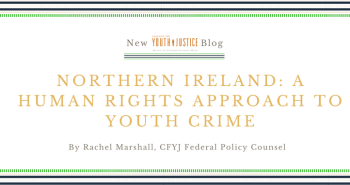Northern Ireland: A Human Rights Approach to Youth Crime

By Rachel Marshall, Federal Policy Counsel
In 1998, the Good Friday Agreement brought an end to three decades of conflict in Northern Ireland known as “The Troubles.” Even after the peace process, many in Northern Ireland harbored a deep distrust in police and the larger justice system. As part of the healing process, the government realized a complete overhaul of the justice system was needed. From this realization emerged a focus on restorative justice. In 2002, the Northern Ireland Justice Act created a statutory scheme for juvenile justice establishing a restorative justice model as the primary mode of intervention for justice-involved youth. While the model was initially established for 10-16 year olds, in 2005 the statute was expanded to include 17 year olds. Restorative justice is used both in pre-sentence diversion, as well as court-based intervention, with most low-level offenses dismissed with only a “caution.”
On November 16, the National Juvenile Justice Network brought together a group of American juvenile justice advocates and practitioners with a delegation of restorative justice (RJ) practitioners from Northern Ireland for a discussion on the integration of restorative justice in Northern Ireland’s youth justice system. The Northern Ireland practitioners represented the two community-based programs that are accredited by the government to work with justice-involved youth, Northern Ireland Alternatives and Community Restorative Justice Ireland.
As a country that leads the industrialized world in the number and percentage of incarcerated children, the U.S. could learn a lot from our friends in Northern Ireland, a country that went from practices that included scheduled beatings and the expulsion of a child’s entire family from his or her community, to a model that uses incarceration as a last resort. Moving from such a harsh system to one of restorative justice was not an overnight process in Northern Ireland. In fact, RJ practitioners explained that the government conducted a two-year review of the justice system, which included a visit to other countries, such as New Zealand, to study different justice systems.
The restorative justice model adopted by Northern Ireland aims to give youth offenders an opportunity to understand the consequences of their actions and make amends to their victims. A family conferencing process is used and involves the youth, the youth’s family, the victim(s), and the community. Through our conversations, we learned that this system is not a completely foreign concept in the U.S. In fact, representatives from the District of Columbia’s Office of the Attorney General explained their own restorative justice program with justice-involved youth. Prosecutors in the District can now refer certain juvenile cases to the restorative justice program, which uses a community conferencing model similar to the one used in Northern Ireland.
In discussing how to better influence policymakers that a restorative justice model is the right choice, the RJ practitioners explained that the money argument has worked best in Northern Ireland. Restorative justice is not only cheaper, but it has better outcomes for youth. This argument was not lost on U.S. advocates, as studies have found that the average cost of confinement of a young person in our country is over $400 a day.
What surprised the Northern Ireland delegation the most was the lack of a rights-based framework in the U.S. In Northern Ireland, even the police operate under a human rights framework, which is reflected in both the policies and practices of the police. The RJ practitioners explained that, as part of a focus on human rights, they made the decision to use the term “police service” versus “police force,” and noted that there is a Northern Ireland Policing Board, which is responsible for monitoring the police to ensure they are complying with the Human Rights Act. The Board is comprised of 19 members and includes politicians and members of civil society. In discussing police bias in the two countries, the RJ practitioners said bias in Northern Ireland typically comes in the form of class bias versus race bias like in the U.S.
While Northern Ireland’s restorative justice model is not without its criticisms and problems, it was a wonderful opportunity to hear about their restorative justice practices straight from the providers. In integrating the restorative justice model, advocates in Northern Ireland have faced challenges not dissimilar to what advocates face in the U.S. After hearing about the successes in Northern Ireland, it is clear that the U.S. juven

